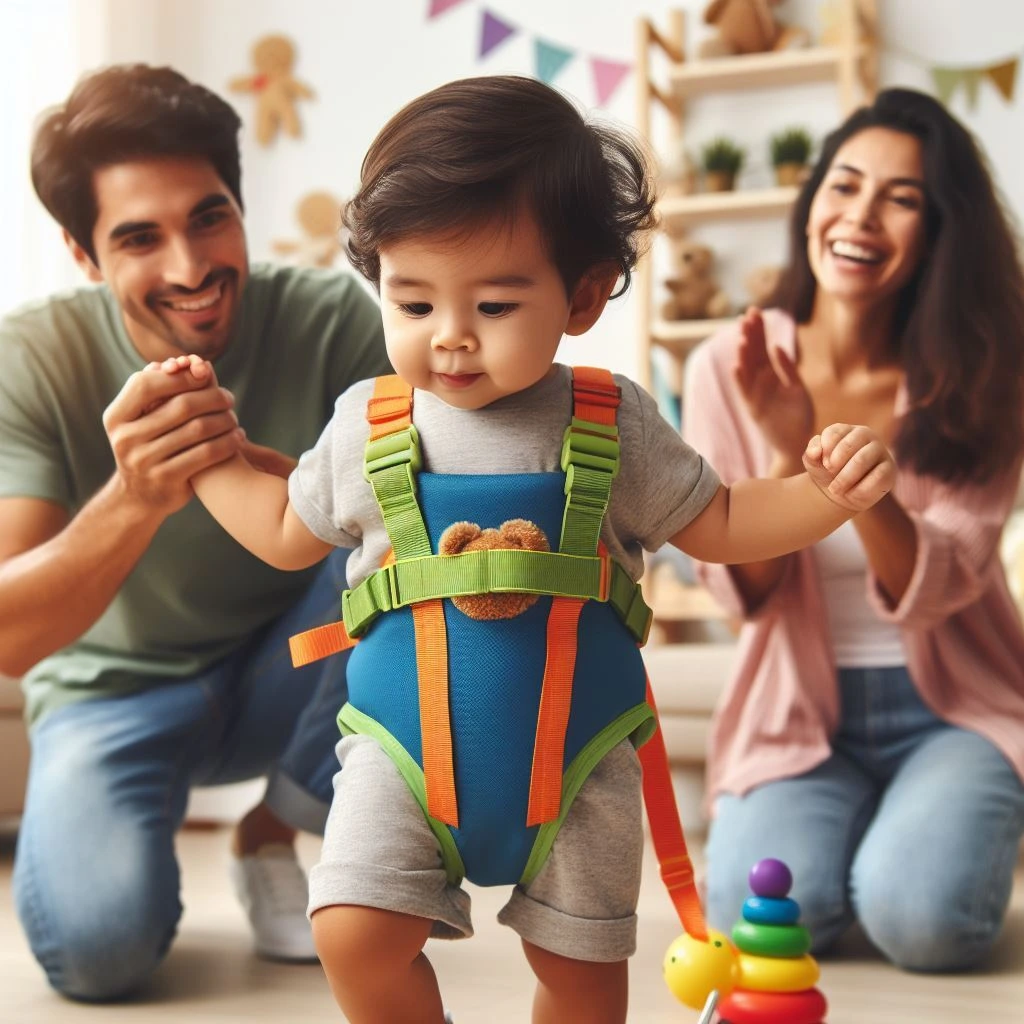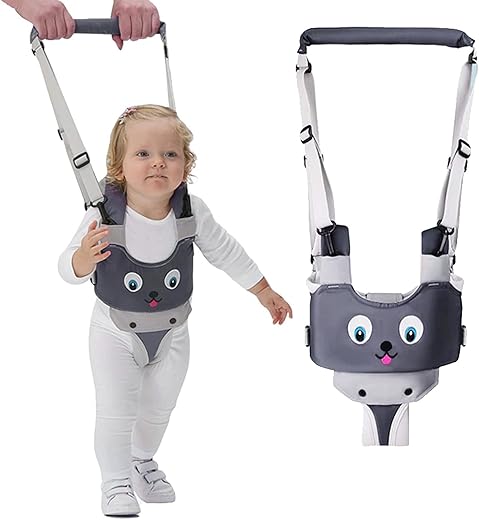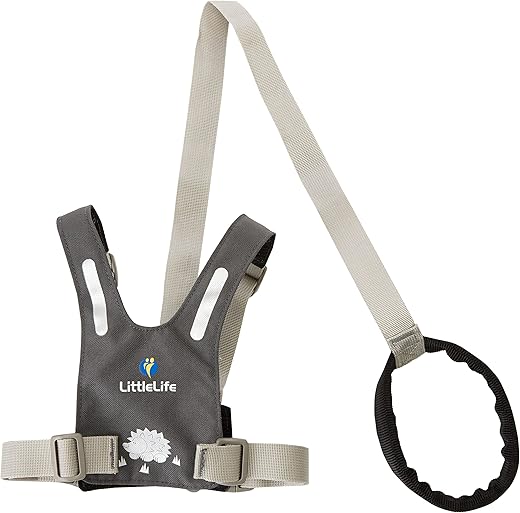Chapter 1. Introduction
1.1. Understanding Baby Harnesses
Baby harnesses represent an innovative approach to parenting aid. These purposeful tools redefine safety measures for infants and toddlers, offering both a sense of security and enhanced freedom within controlled boundaries.
Definition and Purpose
A baby harness, commonly known as a child leash or toddler harness, is a safety device designed to provide parental supervision while enabling a child to explore surroundings securely. Unlike restrictive measures, these harnesses grant children a degree of autonomy while ensuring their safety.
Evolution and Adoption in Parenting
The evolution of these harnesses signifies a shift in parental strategies towards safety-conscious yet freedom-enabling methods. Initially perceived with scepticism, their adoption now reflects a growing understanding of the importance of balance between exploration and safety in child development.
1.2. Importance of Safety in Baby Care
Safety forms the cornerstone of caring for infants and young children. Harnesses emerge as a reliable safety adjunct, offering a safety net in situations where a child’s impulsivity might lead to unforeseen dangers.
Balancing Safety and Freedom
They cater to the fundamental parental concern: safeguarding children without stifling their innate curiosity and desire for exploration. This balance is pivotal in fostering a child’s cognitive and physical development.
Role in Child Development
Harnesses play a nuanced role in nurturing a child’s sense of independence while safeguarding them from potential hazards. They contribute to a child’s growing confidence, facilitating their navigation through environments that might otherwise pose risks.
The Introduction chapter sets the stage, laying the foundation for a detailed exploration of the multifaceted aspects associated with baby harnesses. Understanding the core purpose and safety implications of these tools is pivotal for parents and caregivers aiming to make informed decisions for their child’s well-being.
Chapter 2. The Controversy Around Baby Harnesses
2.1. Debunking Concerns and Misconceptions
In the realm of child safety, the use of baby harnesses has sparked debates, leading to prevalent concerns and misconceptions among parents and caregivers. Addressing these apprehensions is crucial in understanding the nuanced landscape surrounding the use of harnesses.
- Safety vs. Constraint: A common misconception revolves around the notion that harnesses restrict a child’s movement excessively. However, modern harness designs prioritize controlled freedom, allowing children to explore while ensuring their safety.
- Social Stigma: There’s an underlying social stigma associated with using baby harnesses, often linked to judgments or concerns about parenting styles. Overcoming this stigma necessitates a shift in perception, viewing harnesses as safety aids rather than restraints.
2.2. Exploring the Varied Benefits and Drawbacks
Understanding the spectrum of benefits and drawbacks associated with baby harnesses entails a comprehensive evaluation of their practical implications. These nuances can guide caregivers in making informed decisions.
- Safety Enhancement: A primary benefit is the bolstered safety these harnesses offer, especially in crowded or unfamiliar settings. They act as a preventive measure against potential accidents.
- Potential Drawbacks: Challenges arise concerning the perception of child freedom. Some argue that harnesses might impede a child’s sense of autonomy or hinder their exploration, although these views often overlook the controlled freedom aspect.
Navigating the controversy surrounding baby harnesses necessitates an exploration of these misconceptions and a balanced view of their benefits and drawbacks. This chapter aims to provide clarity by dissecting prevalent concerns and elucidating the multifaceted nature of harness usage.
Chapter 3. Types of Baby Harnesses
3.1. Handheld Baby Walkers
Handheld baby walkers are innovative devices designed to assist infants in their early mobility stages. They come with a variety of functionalities that cater to both parental needs and a child’s developmental milestones.
- Functionality and Design
- These walkers typically feature a frame with handles, allowing parents or caregivers to hold and support a child while they practice standing or taking initial steps.
- The design often incorporates interactive elements like toys, buttons, or sound features to engage the child during their walking practice.
- Pros and Cons
- Advantages: Handheld walkers promote balance and coordination as children start exploring movement. They offer sturdy support, aiding in the development of leg muscles and overall motor skills.
- Considerations: However, prolonged use might potentially delay a child’s natural walking progression. Experts suggest limited usage to avoid dependency and encourage independent walking.
3.2. Chest Harnesses and Backpack Styles
Chest harnesses and backpack-style baby harnesses present alternative options for safety and mobility assistance. These variations cater to different preferences and situations, offering distinct features and adaptability.
- Features and Variations
- Chest Harnesses: These harnesses secure around a child’s chest, providing freedom of movement while maintaining close parental supervision.
- Backpack Styles: Backpack harnesses incorporate a playful design that doubles as a safety measure. They feature straps for parental control and a small backpack space for child essentials, adding a functional dimension to safety.
- Suitability for Different Age Groups
- Chest Harnesses: Ideal for younger infants or toddlers who need close supervision while developing motor skills.
- Backpack Styles: Often preferred by slightly older toddlers who seek more independence but still require parental guidance in crowded or unfamiliar environments.
3.3. Child Leashes and Wrist Straps
These accessories serve as extensions to harnesses, providing additional control over a child’s movement in public settings. They serve specific purposes and offer a different level of safety and reassurance.
- Overview of Their Effectiveness
- Child Leashes: These extensions, resembling traditional leashes, allow parents to maintain proximity with a child in crowded or potentially unsafe spaces, reducing the risk of wandering.
- Wrist Straps: With a focus on wrist attachment, these accessories enable parents to hold onto a child’s wrist, offering a close yet less conspicuous method of maintaining control.
- Effectiveness and Limitations
- Effectiveness: Leashes and wrist straps act as an added layer of safety, especially in high-traffic areas or situations where a child’s impulsivity might pose risks.
- Limitations: Overreliance on these accessories might inadvertently hinder a child’s sense of independence and exploration, warranting judicious use.
Understanding the diverse range of harness types available enables parents to choose devices that best suit their child’s developmental stage, needs, and the intended environments where these aids will be utilized.
Chapter 4. How to Choose the Right Baby Harness
When navigating the plethora of baby harnesses available in the market, selecting the most suitable one for your child requires careful consideration. Various factors come into play, ensuring not only safety but also comfort and functionality.
4.1. Considerations Before Purchase
- Safety Standards and Certification
- Prioritize harnesses compliant with safety regulations and certifications. Look for labels indicating adherence to safety standards, ensuring the product has undergone rigorous testing for durability and child safety.
- Comfort and Adjustability
- Opt for harnesses designed with soft, breathable materials that prevent skin irritation. Adjustable straps and padding around critical contact points enhance a child’s comfort while maintaining a snug yet non-restrictive fit.
4.2. Assessing Child’s Needs and Age
- Matching Harness Types to Developmental Stages
- Consider the developmental stage of your child. For infants, chest harnesses or handheld walkers might be suitable, whereas backpack-style harnesses could be more fitting for toddlers exploring their independence.
- Customizing for Individual Children
- Each child is unique; assess their personality and temperament. Some children might feel more at ease with certain harness styles. Flexibility in choosing a harness that aligns with their comfort and preferences can positively impact their experience.
When contemplating the purchase of a baby harness, conducting thorough research on various brands, reading user reviews, and seeking recommendations from parenting forums can aid in making an informed decision. Additionally, considering your child’s specific needs and their stage of development will guide you towards selecting the most appropriate harness for their safety and comfort.
Chapter 5. Assessing the Usefulness in Different Scenarios
5.1. Harnesses in Crowded Public Spaces
Harnesses for babies and toddlers serve as a practical safety measure in bustling public environments, ensuring both the child’s safety and the caregiver’s peace of mind.
Benefits in Crowded Settings:
- Prevention of Straying: In places like malls or crowded streets, harnesses prevent children from wandering away or getting lost in the crowd, offering a secure physical attachment.
- Immediate Control: When surrounded by a multitude of people, harnesses provide immediate control, preventing any unexpected movements or accidental separations.
- Enhanced Supervision: Parents can focus on navigating through crowds without compromising on supervising their child’s movement and safety.
Considerations:
- Public Perception: While harnesses are beneficial, some onlookers might perceive them negatively, mistakenly associating them with overprotection rather than safety.
- Encouraging Independence: There’s a delicate balance between safety and allowing children to explore. In crowded spaces, harnesses should offer safety without restricting a child’s curiosity or movement.
5.2. Harnesses During Outdoor Activities
In outdoor environments, baby harnesses can provide both safety and the freedom necessary for children to explore and learn.
Safety Amidst Adventure:
- Exploration with Safety: Whether hiking, visiting parks, or exploring nature, harnesses permit children to wander within a safe range, preventing accidental falls or getting lost.
- Emergency Situations: In unforeseen situations like uneven terrain or unexpected wildlife encounters, harnesses offer a secure attachment, preventing accidents or sudden movements.
Factors to Consider:
- Freedom of Movement: While ensuring safety, harnesses should encourage movement and exploration, allowing children to learn and enjoy outdoor experiences.
- Comfort and Adaptability: Opting for a harness that adapts to different outdoor activities ensures children remain comfortable during longer periods of wear.
Understanding the benefits and considerations of using harnesses in various scenarios aids parents in making informed decisions regarding their utility and appropriateness based on the specific environment and activity.
Chapter 6. The Importance of Proper Usage
Ensuring the appropriate use of child harnesses is pivotal in optimizing safety and comfort for both the child and the caregiver.
6.1. Guidelines for Correct Fitting and Adjustment
Proper fitting is the cornerstone of harness effectiveness, guaranteeing maximum safety and minimal discomfort.
Essential Fitting Guidelines:
- Secure Straps and Buckles: Confirm all straps are appropriately fastened, ensuring a snug fit without excessive tightness.
- Positioning of Harness: The harness should rest comfortably on the child’s body, ensuring no chafing or rubbing against the skin while maintaining a secure hold.
- Adjustment for Growth: Regularly check and readjust the harness to accommodate a growing child. The harness should adapt to the child’s size and development stages.
- Placement of Tether: For leashes or tethers, the attachment point should be secure, avoiding any risk of entanglement or strangulation.
6.2. Ensuring Comfort Alongside Safety
While prioritizing safety, maintaining the child’s comfort is equally imperative for harness usage.
Comfort Optimization:
- Fabric Selection: Choose harnesses made of breathable and soft materials, minimizing skin irritation and ensuring comfort during extended wear.
- Padding and Adjustability: Opt for harnesses equipped with adequate padding, especially in areas prone to pressure points. Adjustable straps ensure a snug fit without compromising comfort.
- Allowing Movement: The harness should permit the child to move naturally without restricting activities or hindering exploration.
- Temperature Consideration: In hot climates, prioritize harnesses that prevent overheating, while in colder conditions, opt for designs that maintain warmth without compromising mobility.
Understanding the nuances of fitting and comfort in harness usage not only guarantees optimal safety for the child but also ensures a positive experience for both the child and the caregiver, fostering a harmonious balance between safety and comfort.
Chapter 7. Addressing Common Concerns and FAQs
Understanding and clarifying common concerns and queries regarding the use of baby harnesses ensures informed decision-making among parents and caregivers.
7.1. Semantically Similar FAQs:
Are baby harnesses restricting for child development?
There’s a common misconception that harnesses impede a child’s development. However, when used appropriately, harnesses neither hinder nor promote development. Instead, they serve as a safety tool, allowing children to explore within safe limits.
What age is suitable for a baby to start using a harness?
The suitability of a harness largely depends on the child’s mobility and the caregiver’s judgment. Typically, when a child starts walking or shows signs of increased mobility, a harness might be considered. However, it’s essential to ensure the harness doesn’t restrict natural movement or exploration.
Can baby harnesses replace parental supervision?
Harnesses are complementary safety tools, not substitutes for vigilant parental supervision. They serve as a secondary safety measure, providing an added layer of protection in scenarios where keeping a close eye on an active child might be challenging.
Addressing these frequently asked questions eliminates misconceptions, offering clarity on the role and limitations of baby harnesses in child safety.
Chapter 8. Conclusion
Concluding the discourse on baby harnesses, it’s imperative to highlight the overarching safety benefits and encourage thoughtful decision-making for parents and caregivers.
8.1. Summarizing Safety Aspects and Benefits
Baby harnesses, when utilized judiciously, serve as a safety adjunct in various scenarios, offering:
- Enhanced Safety: These harnesses act as a supplementary safety measure, preventing accidental falls or wandering in crowded spaces.
- Freedom with Control: Harnesses grant children a degree of freedom while allowing caregivers control in potentially risky situations.
- Peace of Mind: For parents, harnesses offer peace of mind, especially in bustling environments or during outdoor activities.
8.2. Encouraging Informed Decision-Making for Parents
Empowering parents with informed choices involves:
- Education and Awareness: Encouraging parents to understand the purpose, correct usage, and limitations of harnesses through accessible and accurate information.
- Evaluating Individual Needs: Advocating for a nuanced approach, where decisions about harness use factor in a child’s temperament, mobility, and specific circumstances.
- Safety as Priority: Emphasizing that harnesses should complement, not replace, vigilant parental supervision, ensuring the child’s safety remains paramount.
In conclusion, the efficacy and appropriateness of baby harnesses revolve around a balanced approach, informed decisions, and a focus on child safety and comfort.














